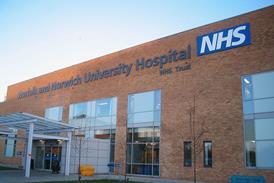Essential insight into England’s biggest health economy, by Ben Clover
“Closer working”
One of the things the new regional director for London, Sir David Sloman, is said to be particularly interested in is how long remains of trust chairs’ terms.
This makes sense if you are interested in who can veto their trust’s involvement in regional plans – and what regional director wouldn’t be interested in that?
The unprecedented joint chairing of King’s College Hospital Foundation Trust and Guy’s and St Thomas’ Foundation by Sir Hugh Taylor has already been discussed and, for good or ill, organisational sovereignty at trust level is boiling away.
There are signs of more to come.
This week both of north central London’s mental health providers announced plans for closer working. This is not a full merger or the sharing of senior leadership, but the organisations are looking at collaborating on three or four services and sharing a couple of back office functions.
So far, so South London Partnership.
But it’s worth looking at the implications of what the senior leadership have said about this.
Sir David, the new NHS England and Improvement regional director, said in a statement: “We know already that having a shared vision and working collaboratively together in this way can deliver major results and significantly improve the lives of the local population”. He doesn’t say how.
The implication of this though is at the moment Barnet Enfield and Haringey Mental Health Trust does not have a shared vision with or work collaboratively enough with Camden & Islington Foundation Trust – and that care is “significantly” less good than it could be as a result.
There are always ways to improve services, especially across organisations.
And if north central London has not pursued these opportunities as much as it could then perhaps it’s another thing to blame Andrew (now Lord) Lansley for. His abolition of strategic health authorities in 2013 meant opportunities were missed – especially opportunities whose uptake might need to be mandated.
Our story last week on lung cancer deaths and governance across two neighbouring hospitals shows how fudged things can end up if a change to a service is resisted.
If there was still a London strategic health authority you might not have needed to hire Sir Robert Naylor to push through major capital schemes like Project Oriel.
BEHMHT and C&I – the two parties to the new joint working – are components in this ambitious plan to move Moorfields Eye Hospital out of its current home and into land owned by C&I in St Pancras.
Sir Robert has sped things up there but there is still a way to go.
One of the things that could prevent a full merger between C&I and its neighbour to the north is the fact that C&I is a foundation trust and can only have an NHS Improvement-mandated chair forced on it if it falls into special measures (as King’s did).
And full mergers are historically a pain anyway: witness the problems in Whittington Health over the differences in London-weighting payments for community services staff working in inner London Islington compared to (technically) outer London Haringey.
King George
Another shared chair is Joe Fielder – who chairs Barking, Havering and Redbridge University Hospitals Trust and North East London Foundation Trust.
The former is a not-well-regarded organisation, almost the inverse of the latter. So if, as rumoured, the regional team had asked Mr Fielder to look at chain or merger options it would be interesting to see if the governors at NELFT would let it fly.
Almost entirely overlooked, foundation trust governors technically have the final say on significant organisational transactions like a merger or a chain.
More tangibly in that neck of the woods, there is thought to be movement on the King George Hospital front.
BHRUHT runs two accident and emergency units – one in a PFI hospital at Romford and the other at King George Hospital – so it is obvious which one you would close if you wanted to close one.
And for a long time people did want to close King George’s A&E, to much local chagrin.
This prospect receded and was abandoned two years ago as demand for the service continued to grow. Apparently that is now starting to change with the prospect of downgrade being raised again, alongside some work on “fragile” (ie: dangerous) services.
However, on April 1st the trust said “there will continue to be an Accident and Emergency unit at King George Hospital” - so there appears to be some conflicting information around.
Topics
- BARKING, HAVERING AND REDBRIDGE UNIVERSITY HOSPITALS NHS TRUST
- BARNET, ENFIELD AND HARINGEY MH NHS TRUST
- CAMDEN AND ISLINGTON NHS FOUNDATION TRUST
- Competition and co-operation
- Finance
- GUY'S AND ST THOMAS' NHS FOUNDATION TRUST
- London
- NHS England (Commissioning Board)
- NHS Improvement
- North East London NHS Foundation Trust
- OXLEAS NHS FOUNDATION TRUST
- Reconfiguration
- South London and Maudsley NHS Foundation Trust
- SOUTHWEST LONDON AND ST GEORGE'S MH NHS TRUST
- Whittington Health NHS Trust


























No comments yet